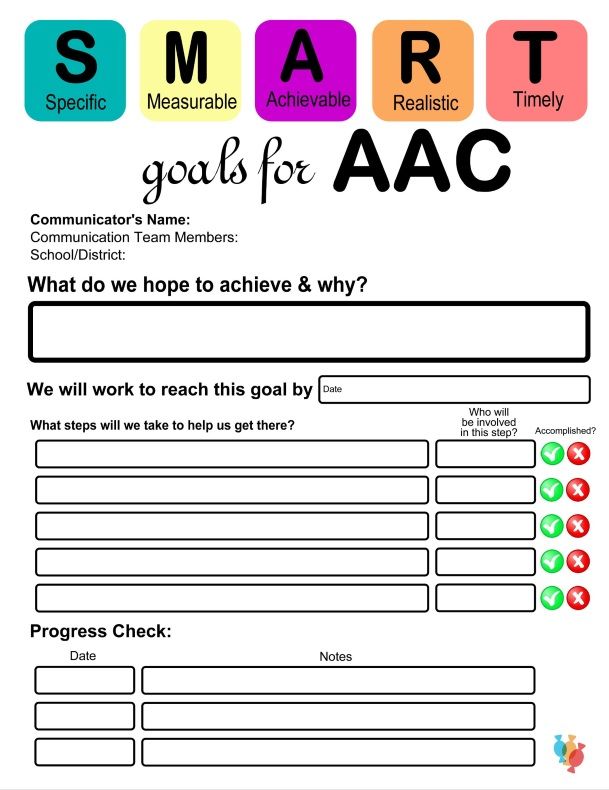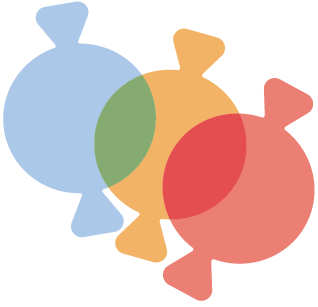It’s a good GOAL!
Are you feeling “stuck” in the AAC implementation process? Do you feel like your learner with complex communication needs has plateaued in their communication and language skill growth?
Are you and/your learner tired of working on the same goals that they have had for months or even years? Has your learner outgrown their current goals and now they feel irrelevant? Do you simply need to create goals for your learner from scratch?
Whether you are a professional, educator, parent, or caregiver to a learner with complex communication needs, you may have answered “yes!” to one or more of these questions.
It is easy to get caught up in the busyness of life and school and forget to adjust goals for learners as they advance and grow in their language or communication skills. That may cause you to feel “stuck” as though they are not making further progress.
The beginning of a new school year, calendar year, and academic semester are prime opportunities to reflect on your AAC implementation efforts and the progress of your learners with complex communication needs. This is the time for you to adjust current communication and language goals so that they are appropriate for the learner’s current skill levels and provide a trajectory of further growth.
If you realize that current goals have been met or are no longer appropriate, perhaps it’s time to formulate new goals. Sometimes, formulating goals can feel overwhelming. However, it is crucial to have appropriate goals in place as they are the driving force of the AAC implementation process and facilitate collaboration among members of support teams so that everyone is on the same page regarding the learner’s current and projected skills.
Do you feel anxious or lost with formulating learner-appropriate goals? Have no fear because we have you covered with a simple set of guidelines to help you get started formulating goals that will exponentially grow your learner’s communication and language skill development.
AAC SMART goals provide an outline to make sure that objectives get met in an appropriate time frame. SMART AAC goals are:
- Specific - What is the specific skill related to language or communication you want the learner to achieve? A clear specific goal allows you to know exactly what you are working towards and increases the likelihood of your learner achieving the goal.
For example, if you would like your learner to develop spontaneous novel utterance generation (SNUG) skills, the goal should specify the length of the utterance and the context or activity in which they will generate such utterances (e.g. learner will use their speech-generating device or SGD to generate three-word comments in social situations).
As the learner progresses towards achieving the goal, expand the specifications so that the learner applies the skill in varying contexts and/or activities. - Measurable - Is the learner’s progress towards the achievement of the specified objective measurable? If so, how will you measure such progress?
Markers of progress and achievements of the goal should be specified so that all members of the support team know what to look for when tracking and targeting the goal. When the goal is measurable, not only can progress be tracked, but you will also know when it is time to increase the complexity of the goal to further skill development in the specified goal area.
The goal should specify the frequency of effective demonstration of the skill in which the goal is targeting. For example, the goal may be that the learner will use their SDG to produce social greetings five out of seven days per week. Upon the learner consistently producing social greetings 80% of the time, the goal has been met and it is time to increase the complexity of the goal. - Achievable - Can the learner achieve the specified goal? Is it a realistic one for them to achieve considering their current skill level? This is especially important for learners with complex communication needs who are in the early phases of their journey with AAC.
Appropriate goals will them feel capable of developing skills and becoming an independent communicator. They need to feel, see, and hear that they are achieving goals so that they stay motivated to use the AAC system and continue learning. Breaking down goals into smaller goals makes them less overwhelming to the learner and provides more frequent opportunities for the celebration of the achievement of goals. - Relevant - Is the skill that the specified goal is targeting relevant to the learner? Will it enhance their ability to effectively and efficiently engage in interactions and activities in which they wish to participate in? Did you seek the learner's input regarding this goal and seek to include their needs and feelings from the beginning? The specified goal should be relevant to the learner and increase their functional abilities in their immediate life situation.
- Time-bound - When would you and the learning like to achieve the specified goal? This helps keep members of the AAC support team accountable and on track on working on the goal. It also helps to know if it is appropriate to break down the specified goal into smaller goals to keep the learner motivated.
When formulating goals, it is imperative to address all of the communicative functions so that learners develop skills to become competent communicators and can say whatever they want whenever they want to say it (see Van Tatenhove, 2016 for a full list of communicative functions).
While it is very challenging to formulate one goal that targets all of the communicative functions, you should formulate multiple goals for your learner to develop skills in all five of the communicative function areas.
When starting to formulate goals, start one step above the learner’s current language level in order to set high yet realistic expectations for their learning, growth, and performance. Continue this pattern as they advance in their skills so that they reach their highest potential. You don’t know their full potential unless they are encouraged and adequately supported to uncover it.
If you are feeling “stuck” with developing SMART goals for your learners, the AACP: Augmentative & Alternative Communication Profile: A Continuum of Learning (Kovach, 2009) can be used to identify areas of strength and those that can be further developed. This tool is geared toward SLPs.
The Communication Matrix (Rowland, 2013) is another tool that is very helpful in determining the learner’s current communication methods and suggests an outline for developing communication goals that are relevant to the learner’s situation. This assessment is user-friendly not only to SLPs, but also to parents, teachers, and other members of support teams.
Collaboration and communication among members of support teams are crucial. All members – especially the communicator – should be communicating their hopes for the future, as well as what they are observing in regard to the learner’s progress toward the goal.
Once the learner’s goals have been formulated, it is important to communicate the goals clearly to all members of the support team so that they can help monitor progress towards achieving the goals and also support the learner in working to develop skills related to these goals when opportunities arise. It is crucial to maintain consistent support and modeling across all members of the support team so that progress can be accurately measured and encouraged. The Prompt Hierarchy Umbrella InfoGraph (Ahern & Nelsen, 2016) is a great resource to give to members of support teams to ensure consistent levels of support.
The AAC implementation process is a marathon, not a sprint. Put in the adequate time and thought into formulating goals for your learner to set them up for success. The way that the AAC team supports learners has a profound impact on their growth trajectory. It all begins with a good goal!

References
Ahern, K., & Nielsen, S. (2016). Prompt Hierarchy Umbrella InfoGraph. PrAACtical AAC. Carole Zangari. Retrieved December 15, 2022, from https://praacticalaac.org/praactical/building-aac-facilitation-skills-with-tabi-jones-wohleber-master-pal-training-module-9-appropriate-prompting/.
Kovach, T. (2009). AACP: Augmentative & Alternative Communication Profile: A Continuum of Learning. PRO-ED Inc..
Rowland, C. (2013). Handbook: Online Communication Matrix. Portland, OR; Design To Learn.
Van Tatenhove, G. M. (2016, November). Normal Language Acquisition & Children using AAC Systems. Orlando, FL; Van Tatenhove.
